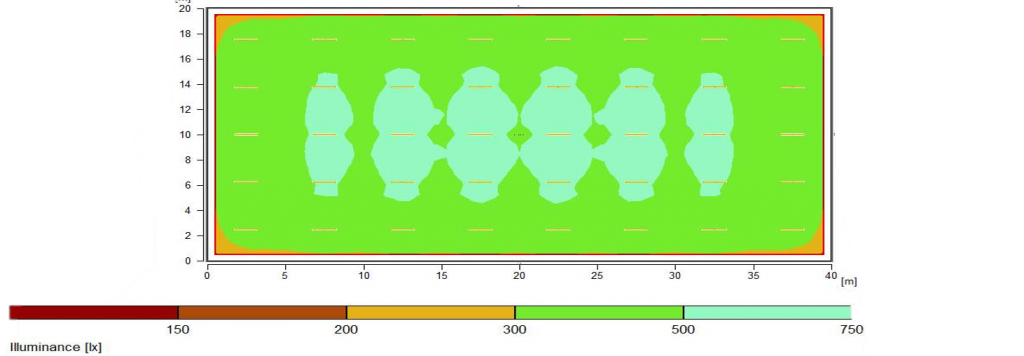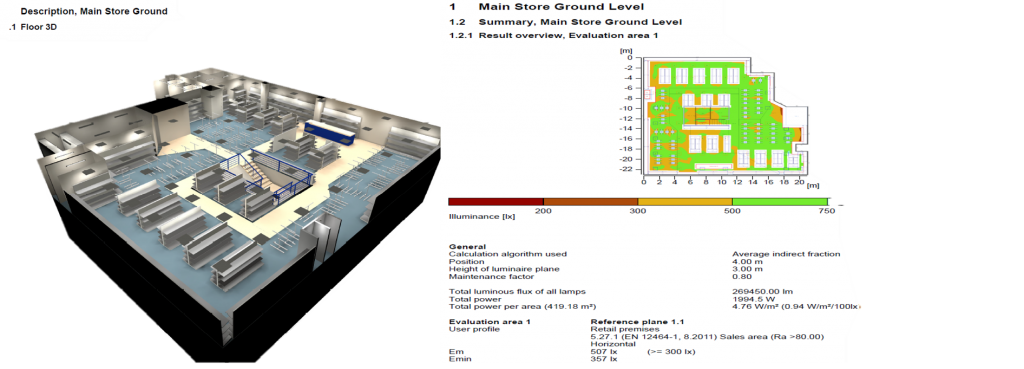Who wouldn’t want to install LED Lighting
Let’s start with the objections:
- We have our own electricians
- We use a contractor for all our electrical work
- We just replace lights as they fail – whatever the wholesaler has in stock
- We’ve heard horror stories about LED
We’ll return to these later!
First we’ll need a bit of lighting terminology:
- CCT – correlated colour temperature of the light
- K (kelvin) – CCT measured in kelvin temperature
- CRI – how close objects look to their true colour
- Uo – uniform distribution of light (e.g. shadows)
- UGR – glare
And we’ll consider some basics about natural and electromagnetic lighting
- Humans have evolved over 60 million years in natural lighting
- And have adapted/ adjusted over 150 years to artificial lighting
- We see a tiny fraction of the light spectrum – 450 to 700 nm


Does this matter? Well yes, very much so!
Natural Light
- CRI is true – objects appear 100% their natural colour.
- Uo is true – shadows only where they should be.
- Photopic, Mysopic, Scotopic vision – cones & receptors
- Zircadian Rhythm – sleep/wake cycle – production of vital chemicals (serotonin, dopamine, vitamin D)
- improved focus, efficiency, motivation
- Effect on physical & mental well-being
We’ve evolved into what we are under natural lighting
Electromagnetic Lighting
Lets us work more effectively indoors & at night at a costs to
Health:
- Inconsistent colours (CCT)
- Flicker, Hum (migraines, tiredness) UV output
- Dangerous chemicals – e.g. mercury
- Much diminished CRI (65%)
- Variable Uo depending on design – shadows where we don’t want then
Perception & performance
- Clothes in a shop
- Produce on shelves
- Medics examining patients
- Printing, painting & other colour reproductions
- And virtually everything!
Couple of examples
Printers, paint shops specify 6000 K (blue/white & looks bright)
WRONG!
They need 4,000K & 90 CRI to reproduce true colours
– The higher the CCT the lower the CRI
For produce on shelves we may not want to show true colour (!)
– We may want the red apples to look “redder” and the crisp packets to contrast more….
Uo, CCT, CRI, Flicker, Hum, affect us, what we do, our perceptions, our behaviours
Artificial lighting does a poor job at all of them, except: LED is very close to natural lighting
-And where it doesn’t “match” it makes up for that with a number of ‘compensators’:
- CCT is precise
- CRI up to 90%
- Flicker reduced to ripple & no hum
- Good designs optimise Uo
- All contribute to positive Circadian rhythm close to natural light- – patients sleep better & heal faster under LED
- A compensatory feature may include choosing a colour / CRI to enhance the look of something
And costs just 20% to 25% of electromagnetic light in energy consumption
Specifying LED Lighting
What to specify may seem obvious from the previous slides, but depending on the application, the values will be very different. They need to be right!
- Lux levels
- CCT
- CRI
- Uo
- UGR (glare)
- The values will determine (or be determined by) fixture, mounting height & spaces, obstructions, aesthetics etc…
Lighting Design
Starts with a in-depth survey, taking precise measurements of:
- fixture heights and spaces
- any obstructions to light – machinery, racking, desks & chairs etc
- existing light levels
- existing controls, switching
- existing fixtures (numbers, wattages)
- photographs
Use of design tools & software to produce the lighting design – to meet the specification
- in the surveyed facility
- in the most cost-effective way

We often see competitor designs that show an “empty room” (not many of those!)
if not lazy, then produced by those not skilled or knowledgeable enough, Either way, it is grossly misleading – re lux levels & Uo particularly
Professional Lighting Design

Showing true lux levels Uo, UGR in the actual environment
Typical outcomes
Dramatic improvements in lighting quality
The right colour, objects visible in their true colours, highly uniform, minimal glare
Impacts whole facility: cleaner fresher looking
- Increased productivity, less sickness/ tiredness & absenteeism
- Savings in energy of typically 75% to 80%
- Payback periods of 12 months (9 to 15 typical range)
- No/ minimal maintenance during a very long life (80,000 hours)
One or two “before & afters”

- Gloomy colour / environment replaced with a vibrant one.
- The floor is the same one in both pictures – looks like it had been painted!
- CRI makes ‘picking’ stock so much easier – improving productivity.
- 84% energy savings in this installation – which paid back in 11 months
- Again, a gloomy environment (even during the day with light coming in through sky-lites) transformed. NB the “after photo” taken at night.
- Again, note the floor & the walls not just the task areas
- This company colour mixes raw materials, so Uo and high CRI is vital
- 78% savings, pay back 14 months
Objections re-visited
“We have our own electricians”
Maintenance electricians are not knowledgeable enough about light & lighting.
They have not needed to be historically, and nor have they ever needed to produce a design.
Of course let trusted electricians carry out the installation, which itself should be straight-forward, but not select the product itself.
“We use a contractor for all our electrical work”
As above but with potentially much greater consequences. We see contractors tender for work with lowly priced fixtures not suited for the application either from a total cost (of ownership) quality or reliability perspective.
“We just replace lights as they fail – whatever the wholesaler has in stock”
Again, very few electrical wholesalers employ lighting designers as they have never needed to do so. Wholesalers tend to stock the larger, fast-moving fittings for their own good reason, which by definition is not cohesive to the right design (CCT, CRI, Uo, UGR, Levels) for any specific application. Many are fast-moving fixtures because they are cheap(er) which is – not always but often – not synonymous with long-life, high-efficiency or reliability.
“We’ve heard horror stories about LED”
Indeed there are many of these (note the design example earlier). All of the above can lead to horror stories which can be overcome by having the lighting design done by a lighting design expert. It will cost next to nothing of the cost of a horror story.
Do your due diligence! Professional companies will welcome it.
We trust the foregoing has demonstrated that the world has dramatically changed the world of lighting with the advent of LED. Those who embrace the change will gain enormous advantages it offers.
Natural light is the most beneficial type of light.
However, with most of us forced to spend most of our time indoors, high-quality artificial lighting that is as close to natural light is the next best thing.
By “as close” we mean in light level, colour and colour rendering index (CRI).
Of course, natural light changes in levels and colour during the day; in the morning it will be a warm colour (2500 to 3500 kelvin) rising to typically 4500 to 5500 mid-afternoon and then the reverse into late afternoon & evening. CRI means how close any object looks to its true colour (which is represented by a number). The higher the CRI number, the closer to their true colours they will be.
The “right” light level, colour and CRI will vary with the application (and you should consult with us for guidance on how to specify the lighting).
Once you have produced the specification, high quality LED lighting will deliver precisely the levels, uniformity, colour and CRI.
This is proven to deliver “human centric” benefits, positively affecting our:
- Circadium Rythms*
- Mood
- Visual Acuity
- Productivity and Performance
- Perception
As a result, people feel more motivated and less tired than they have under ‘traditional’ lighting. There are other specific benefits which contribute to productivity too. For those doing precision work or inspecting product for example, do so much more effectively and efficiently.
There are then a whole range of “spin off” benefits. Those working at night always report that it is “like working during the day”. It prevents SAD disorder, greatly reduces migraines typically associated with fluorescent lights.
*A properly functioning circadian rhythm will maximise production of serotonin and dopamine at midday.
Serotonin is a chemical that has a wide variety of functions in the human body. It is sometimes called the happy chemical, because it contributes to wellbeing and happiness. It is mainly found in the brain, bowels, and blood platelets.Dopamine is a chemical found naturally in the human body. It is a neurotransmitter, meaning it sends signals from the body to the brain. Dopamine plays a part in controlling the movements a person makes, as well as their emotional responses. The right balance of dopamine is vital for both physical and mental wellbeing.

Have you thought about adding some sort of bookmarking buttons or links to your website?